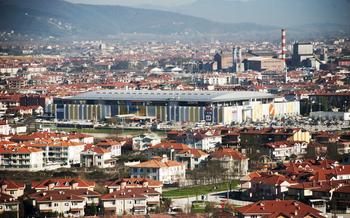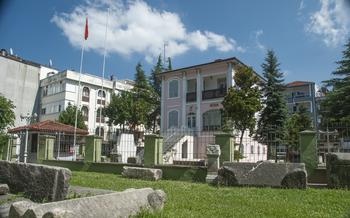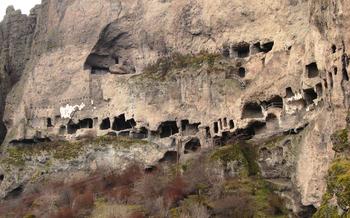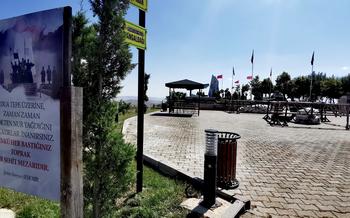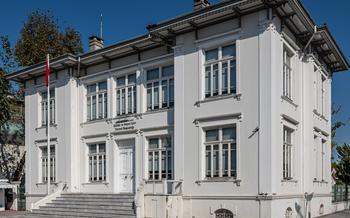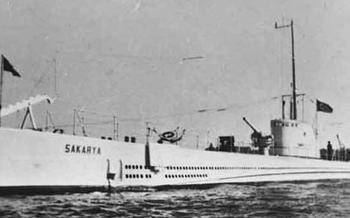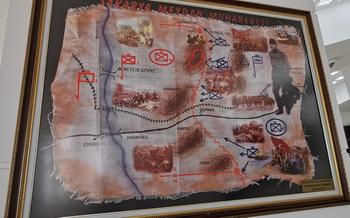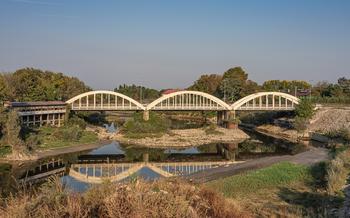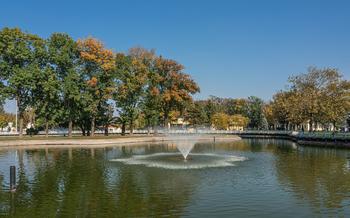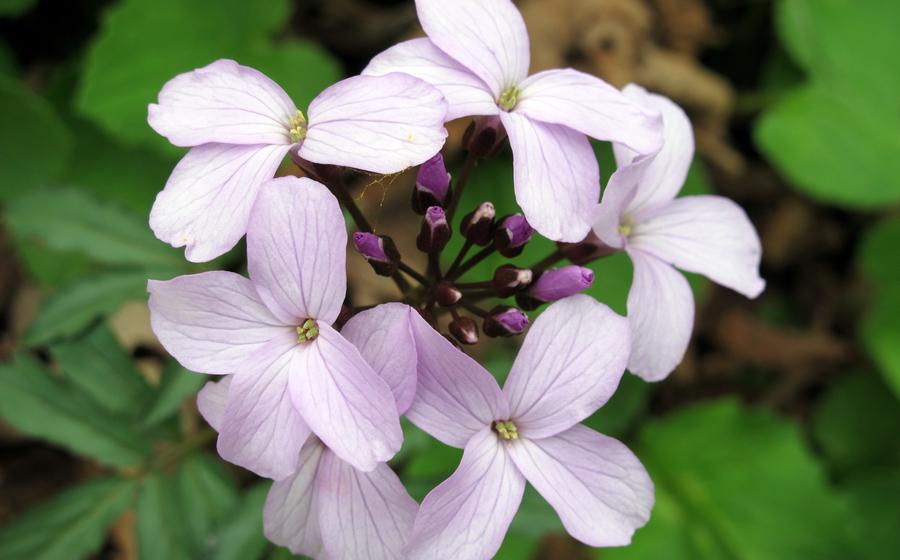
The Earthquake Cultural Museum
- Sakarya: A Vibrant Turkish City
- Unveiling the Earthquake Cultural Museum: A Journey Through History
- Exploring the Museum's Exhibits: A Multisensory Experience
- The 1999 Earthquake: A Defining Moment for Sakarya
- Remembering the Victims: A Tribute to Resilience
- Guided Tours for a Deeper Understanding
- A Symbol of Resilience: The Importance of the Museum
- Interactive Learning for All Ages
- Accessibility and Facilities for Visitors
- Photography and Videography Guidelines
- Plan Your Visit: Essential Information
- Community Engagement and Outreach
- Reflecting on the Past, Embracing the Future
- A Touching Tribute to Survivors and Their Stories
- Insider Tip: Local Delicacies to Try
Sakarya: A Vibrant Turkish City
In the heart of Turkey's northwestern region lies Sakarya, a city pulsating with historical significance and natural allure. Once the site of ancient civilizations, Sakarya boasts a rich tapestry of cultural heritage, proudly preserving its traditions amidst the embrace of modernity. From the grandeur of its historical landmarks to the serene beauty of its natural landscapes, Sakarya offers a captivating blend of history, culture, and breathtaking vistas. Whether exploring its vibrant streets, marveling at its architectural wonders, or indulging in the warmth of local hospitality, Sakarya promises an unforgettable journey for every traveler. As you wander through this charming city, be sure to visit its must-see attractions, each narrating a unique chapter in Sakarya's captivating story.
Unveiling the Earthquake Cultural Museum: A Journey Through History
Established in 2011, the Earthquake Cultural Museum stands as a testament to the resilience and strength of the Sakarya community. The museum commemorates the devastating earthquake of 1999 that shook the city to its core, claiming countless lives and leaving an indelible mark on the collective memory.
The museum's inception serves as a poignant reminder of the profound impact of natural disasters, honoring the victims and paying tribute to their indomitable spirit. It provides a unique platform for visitors to delve into the history of the earthquake and its aftermath, gaining insights into the challenges faced by the local community and the remarkable journey of recovery that ensued.
Designed with sensitivity and respect, the museum's architecture evokes a sense of solemnity and remembrance. Its modern, minimalist facade contrasts with the raw emotion contained within its walls, creating a powerful juxtaposition that captures the essence of the earthquake's aftermath. Inside, visitors are greeted by a tranquil and contemplative space, where they can embark on a journey of discovery and reflection.
Exploring the Museum's Exhibits: A Multisensory Experience
The Earthquake Cultural Museum in Sakarya offers a multisensory experience that brings visitors face-to-face with the devastating 1999 earthquake and its aftermath. Interactive displays and multimedia presentations recount the stories of survivors, showcasing their resilience and strength in the face of adversity. Visitors can handle artifacts and personal belongings that once belonged to those affected by the earthquake, creating a tangible connection to the human toll of the disaster. Seismic simulators provide a visceral experience of the earth's violent tremors, while educational programs and workshops delve deeper into the science and history of earthquakes. The museum's exhibits are not just informative but also emotionally impactful, leaving visitors with a lasting appreciation for the fragility of life and the power of the human spirit.
The 1999 Earthquake: A Defining Moment for Sakarya
On August 17, 1999, a devastating earthquake measuring 6 on the Richter scale struck Turkey, with its epicenter in the city of Gölcük in the Kocaeli Province, just east of Sakarya. The earthquake caused widespread destruction and loss of life, with over 17,000 fatalities, including more than 1,000 in Sakarya itself. The city was severely damaged, with many buildings collapsing and infrastructure crippled.
The earthquake was a defining moment for Sakarya, leaving an indelible mark on the city and its people. The heroism and resilience of the local community were evident in the aftermath of the disaster, as residents came together to rescue survivors, provide aid, and rebuild their lives. International aid and support poured in from countries around the world, demonstrating the global solidarity that can emerge in times of crisis.
The 1999 earthquake served as a wake-up call for Turkey and other earthquake-prone regions, highlighting the importance of disaster preparedness and risk mitigation. Building codes were revised, emergency response systems were improved, and public awareness about earthquake safety was raised. The lessons learned from this tragedy have helped to save lives in subsequent earthquakes, both in Turkey and beyond.
Remembering the Victims: A Tribute to Resilience
In the wake of the devastating earthquake, the people of Sakarya came together to honor and remember the victims. Memorials and commemorative events were held to pay tribute to those who lost their lives. The community united to establish initiatives to honor the departed, such as creating memorial parks and planting trees in their memory. Stories of courage and survival were shared by locals, highlighting the resilience and strength of the human spirit. The Earthquake Cultural Museum serves as a poignant reminder of the tragedy, but also as a testament to the unwavering spirit of the Sakarya community. By remembering the victims and their stories, the museum plays a vital role in fostering a sense of collective remembrance and honoring the legacy of those who were lost.
Guided Tours for a Deeper Understanding
To truly grasp the significance of the Earthquake Cultural Museum and the profound impact of the 1999 earthquake on Sakarya, guided tours are highly recommended. Experienced guides, fluent in multiple languages, provide invaluable insights into the earthquake's devastating effects and the resilience of the local community. They share personal anecdotes, historical context, and expert knowledge, enriching the museum experience and fostering a deeper understanding of the events that shaped Sakarya's history.
These guided tours offer a unique opportunity to engage with the museum's exhibits on a personal level. Guides help visitors understand the significance of artifacts, explain the science behind earthquakes, and share stories of heroism and survival from the earthquake's aftermath. They facilitate meaningful discussions and encourage visitors to reflect on the importance of disaster preparedness and community resilience.
Whether you're a history buff, a student, or simply someone seeking a deeper connection to the stories of human resilience, the guided tours at the Earthquake Cultural Museum are an invaluable resource. They provide a comprehensive and emotionally resonant experience, ensuring that visitors leave with a profound understanding of the earthquake's impact and the enduring spirit of the Sakarya community.
A Symbol of Resilience: The Importance of the Museum
The Earthquake Cultural Museum in Sakarya stands as a symbol of hope and renewal, a testament to the resilience of the human spirit in the face of adversity. It serves as a vital platform for preserving the memory of the 1999 earthquake, ensuring that the stories of the victims and the lessons learned are never forgotten. By shedding light on the devastating impact of natural disasters and their aftermath, the museum plays a crucial role in promoting awareness about disaster preparedness and risk mitigation strategies. Moreover, it inspires visitors with the remarkable resilience of the Sakarya community, demonstrating the power of unity and collaboration in overcoming challenges. The museum serves as a reminder of the importance of collective action, empathy, and the indomitable human spirit in the face of adversity.
Interactive Learning for All Ages
The Earthquake Cultural Museum offers a variety of educational programs and workshops tailored for students and families of all ages. These programs are designed to engage participants in interactive activities and experiments that teach about earthquakes in a fun and informative way. Through hands-on learning experiences, visitors can gain a deeper understanding of the science behind earthquakes, the impact they have on communities, and the importance of disaster preparedness. By fostering a culture of disaster awareness among the youth, the museum plays a crucial role in educating future generations about the importance of resilience and risk mitigation.
Accessibility and Facilities for Visitors
The Earthquake Cultural Museum is committed to providing an inclusive and accessible experience for all visitors. Wheelchair users and individuals with limited mobility will find the museum's facilities well-equipped to accommodate their needs. Ramps and elevators ensure that all levels of the museum are accessible, and designated parking spaces are available for those with disabilities.
For international visitors, the museum offers informational materials and exhibits in multiple languages, including English, Arabic, and German. This ensures that everyone has the opportunity to learn about the earthquake and its impact on the Sakarya community.
Cleanliness and maintenance are given utmost importance at the museum. The premises are kept spotless to provide a comfortable and hygienic environment for visitors. Rest areas and refreshment facilities are available within the museum, allowing visitors to take breaks and relax during their exploration.
Photography and Videography Guidelines
The Earthquake Cultural Museum welcomes photography and videography enthusiasts to capture their experiences within the museum. However, to ensure a respectful and immersive environment for all visitors, certain guidelines must be followed:
-
Designated Areas: Photography and videography are permitted in designated areas within the museum. Please be mindful of signage indicating restricted zones where photography is not allowed.
-
Respectful Conduct: While taking photos or videos, please maintain a respectful demeanor and silence to avoid disturbing other visitors' contemplation and reflection.
-
Flash Photography: The use of flash photography is restricted in certain areas of the museum to preserve the integrity of artifacts and exhibits. Please inquire with museum staff for specific guidelines.
-
Tripod Usage: Tripods may be used for stability, but please be considerate of other visitors' movement and ensure that your equipment does not obstruct pathways or exhibits.
-
Responsible Capturing: Remember that the museum is a place of remembrance and reflection. Please capture memories responsibly, respecting the privacy and emotions of earthquake survivors and their families.
Plan Your Visit: Essential Information
To ensure a smooth and enjoyable visit to the Earthquake Cultural Museum, it is advisable to plan ahead:
-
Museum Hours and Admission Fees: The museum is open to the public from 9:00 AM to 5:00 PM, seven days a week. Admission fees are nominal, catering to both local and international visitors.
-
Recommended Duration: Allocate at least two hours for a comprehensive visit to the museum. This will allow sufficient time to explore the exhibits, watch the documentary, and engage with the interactive displays.
-
Peak Seasons and Visitor Flow: The museum experiences a surge in visitors during summer and holidays. To avoid crowds and have a more immersive experience, consider visiting during the off-season or on weekdays.
-
Nearby Attractions and Points of Interest: Combine your visit to the Earthquake Cultural Museum with other attractions in Sakarya, such as the Sakarya Museum, the Historical Clock Tower, and the Sakarya Grand Bazaar. These landmarks offer a glimpse into the city's rich history and cultural heritage.
Community Engagement and Outreach
The Earthquake Cultural Museum actively engages with the local community and extends its reach through various outreach initiatives. It collaborates with schools and organizations to conduct educational programs, raising awareness about earthquakes and disaster preparedness among the younger generation. Volunteering opportunities are available for individuals passionate about contributing to the museum's mission. These programs not only foster a sense of community involvement but also provide valuable hands-on experiences for volunteers. Additionally, the museum hosts community events and workshops that promote resilience, unity, and collective remembrance. These initiatives create a platform for dialogue, sharing, and learning, strengthening the bond between the museum and the community it serves.
Reflecting on the Past, Embracing the Future
The Earthquake Cultural Museum serves as a poignant reminder of the fragility of life and the impermanence of our existence. Through its exhibits and programs, the museum encourages visitors to appreciate the preciousness of the present moment and to embrace gratitude for the blessings in their lives. The stories of resilience and survival shared by earthquake survivors inspire visitors to cultivate a sense of hope and resilience for the future. The museum fosters a spirit of global solidarity and empathy, reminding us that we are all interconnected and that we can overcome adversity together. It encourages visitors to reflect on the past and to learn from the mistakes of the past in order to build a more resilient and compassionate world for the future.
A Touching Tribute to Survivors and Their Stories
The Earthquake Cultural Museum in Sakarya is not just a repository of artifacts and exhibits; it is a sacred space that honors the stories of survivors and their extraordinary journeys of resilience. Through personal narratives, oral histories, and interactive storytelling sessions, the museum allows visitors to connect with the human experiences that unfolded during the devastating earthquake. These accounts, shared by survivors themselves, offer a profound and deeply moving insight into the strength, courage, and determination that emerged amidst the tragedy.
The museum's exhibitions provide a platform for survivors to share their firsthand experiences, recounting the harrowing moments of the earthquake, the challenges they faced, and the inspiring stories of hope and survival that emerged from the ruins. These personal narratives create a powerful bond between visitors and the survivors, fostering empathy, understanding, and a deep appreciation for the resilience of the human spirit.
Through interactive storytelling sessions and exhibitions, visitors are invited to engage with the survivors' journeys on a personal level. They can listen to recorded interviews, view multimedia presentations, and participate in interactive activities that recreate the earthquake's impact. These immersive experiences transport visitors back in time, allowing them to witness the events through the eyes of those who lived through them.
Insider Tip: Local Delicacies to Try
When in Sakarya, don't miss the chance to savor the local cuisine, a delightful blend of Turkish and regional flavors. Start your culinary journey with "Sapanca Gölü Sazan," a must-try dish featuring grilled carp fish caught fresh from Lake Sapanca. Indulge in the rich taste of "Sakarya Mantısı," delicate handmade dumplings filled with seasoned ground beef and topped with garlic yogurt sauce.
Venture into the heart of the city to discover hidden culinary gems. Ask locals for their favorite "pide" spots and enjoy the crispy flatbread topped with various fillings. For a sweet treat, try "kaymaklı ekmek kadayıfı," a luscious dessert made with shredded wheat, clotted cream, and syrup. Don't forget to wash down your meal with a refreshing glass of traditional Turkish tea, a perfect way to end your Sakarya food adventure.
